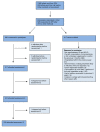Recruiting older people to a randomised controlled dietary intervention trial--how hard can it be?
- PMID: 20175903
- PMCID: PMC2843618
- DOI: 10.1186/1471-2288-10-17
Recruiting older people to a randomised controlled dietary intervention trial--how hard can it be?
Abstract
Background: The success of a human intervention trial depends upon the ability to recruit eligible volunteers. Many trials fail because of unrealistic recruitment targets and flawed recruitment strategies. In order to predict recruitment rates accurately, researchers need information on the relative success of various recruitment strategies. Few published trials include such information and the number of participants screened or approached is not always cited.
Methods: This paper will describe in detail the recruitment strategies employed to identify older adults for recruitment to a 6-month randomised controlled dietary intervention trial which aimed to explore the relationship between diet and immune function (The FIT study). The number of people approached and recruited, and the reasons for exclusion, will be discussed.
Results: Two hundred and seventeen participants were recruited to the trial. A total of 7,482 letters were sent to potential recruits using names and addresses that had been supplied by local Family (General) Practices. Eight hundred and forty three potential recruits replied to all methods of recruitment (528 from GP letters and 315 from other methods). The eligibility of those who replied was determined using a screening telephone interview, 217 of whom were found to be suitable and agreed to take part in the study.
Conclusion: The study demonstrates the application of multiple recruitment methods to successfully recruit older people to a randomised controlled trial. The most successful recruitment method was by contacting potential recruits by letter on NHS headed note paper using contacts provided from General Practices. Ninety percent of recruitment was achieved using this method. Adequate recruitment is fundamental to the success of a research project, and appropriate strategies must therefore be adopted in order to identify eligible individuals and achieve recruitment targets.
Figures
Similar articles
-
Exploring factors influencing recruitment results of nurses recruiting diabetes patients for a randomized controlled trial.Clin Trials. 2020 Aug;17(4):448-458. doi: 10.1177/1740774520914609. Epub 2020 May 5. Clin Trials. 2020. PMID: 32367737 Free PMC article.
-
A dynamic and collaborative approach to trial recruitment in safetxt, a UK sexual health randomised controlled trial.Clin Trials. 2022 Jun;19(3):251-258. doi: 10.1177/17407745221078882. Epub 2022 Mar 5. Clin Trials. 2022. PMID: 35253453 Free PMC article.
-
Trials and tribulations of recruiting 2,000 older women onto a clinical trial investigating falls and fractures: Vital D study.BMC Med Res Methodol. 2009 Nov 25;9:78. doi: 10.1186/1471-2288-9-78. BMC Med Res Methodol. 2009. PMID: 19930724 Free PMC article. Clinical Trial.
-
Recruitment of older adults for a randomized, controlled trial of exercise advice in a general practice setting.J Am Geriatr Soc. 1999 Apr;47(4):477-81. doi: 10.1111/j.1532-5415.1999.tb07242.x. J Am Geriatr Soc. 1999. PMID: 10203125
-
Synthesis of researcher reported strategies to recruit adults of ethnic minorities to clinical trials in the United Kingdom: A systematic review.Contemp Clin Trials. 2019 Mar;78:1-10. doi: 10.1016/j.cct.2019.01.004. Epub 2019 Jan 8. Contemp Clin Trials. 2019. PMID: 30634035
Cited by
-
Recruitment of trial participants through electronic medical record patient portal messaging: A pilot study.Clin Trials. 2020 Feb;17(1):30-38. doi: 10.1177/1740774519873657. Epub 2019 Oct 3. Clin Trials. 2020. PMID: 31581836 Free PMC article.
-
Barriers and enablers to recruiting participants within paediatric perioperative and anaesthetic settings: lessons learned from a trial of melatonin versus midazolam in the premedication of anxious children (the MAGIC trial).BJA Open. 2025 Feb 4;13:100375. doi: 10.1016/j.bjao.2024.100375. eCollection 2025 Mar. BJA Open. 2025. PMID: 39991707 Free PMC article.
-
The cost of community research-recruiting community-dwelling participants to a feasibility primary care cluster randomised controlled trial.Trials. 2021 May 8;22(1):332. doi: 10.1186/s13063-021-05297-3. Trials. 2021. PMID: 33964964 Free PMC article. Clinical Trial.
-
Time to STEP UP: methods and findings from the development of guidance to help researchers design inclusive clinical trials.BMC Med Res Methodol. 2024 Oct 2;24(1):227. doi: 10.1186/s12874-024-02342-y. BMC Med Res Methodol. 2024. PMID: 39358688 Free PMC article.
-
Lifestyle interventions and independence for elders study: recruitment and baseline characteristics.J Gerontol A Biol Sci Med Sci. 2013 Dec;68(12):1549-58. doi: 10.1093/gerona/glt064. Epub 2013 May 28. J Gerontol A Biol Sci Med Sci. 2013. PMID: 23716501 Free PMC article. Clinical Trial.
References
-
- Joanna Bowen SH. Recruitment rates and factors affecting recruitment for a clinical trial of a putative anti-psychotic agent in the treatment of acute schizophrenia. Human Psychopharmacology: Clinical and Experimental. 1992;7(5):337–341. doi: 10.1002/hup.470070507. - DOI
Publication types
MeSH terms
Associated data
LinkOut - more resources
Full Text Sources


